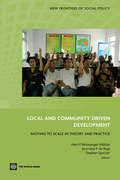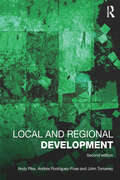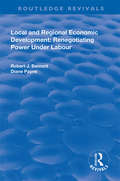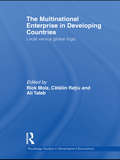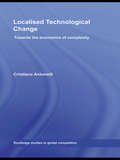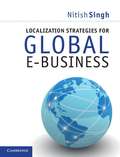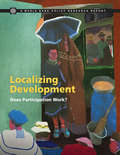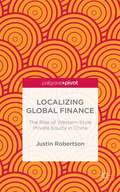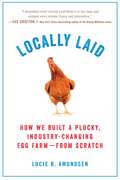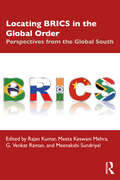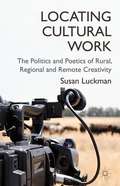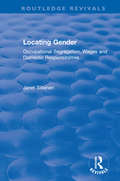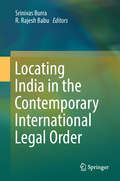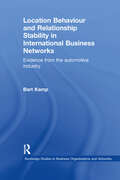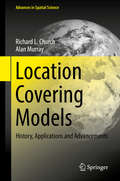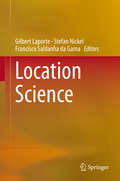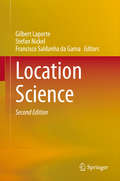- Table View
- List View
Local Tax Policy in Central and Eastern Europe: Property Taxation and Municipal Finance (Routledge Research in Taxation)
by Paweł Felis Leszek Patrzałek Agnieszka Bem Michał Bernardelli Elżbieta Malinowska-Misiąg Jarosław Olejniczak Milena KowalskaThis book navigates the complexities of local real estate taxation in the dynamic region of Central and Eastern Europe, providing a meticulous analysis of the diverse approaches taken across the region. From Poland to Hungary, Romania to the Czech Republic, this book explores the historical roots and evolution of local real estate tax, its importance in municipal fiscal policy and its impact on communities.This book analyses the motives and models used by municipal authorities in their calculations around real estate tax and considers whether they are primarily a fiscal tool, related to budget revenues, or stimulants for future growth aimed at boosting local socio‑economic development. It also explores whether municipalities compete with neighbouring entities on taxation and the extent to which the political cycle and the meeting of voter demands and expectations play a role.This book will be of great interest to readers in public economics and finance, taxation policy and law, local government and the CEE region more broadly.
Local Welfare Policy Making in European Cities
by Dagmar Kutsar Marjo KuronenThis book focuses on how EU welfare policies are implemented at the local level in 11 European cities and how local policy making addresses women's care responsibilities. The book studies the complex combination of and the relationships between local political processes, policies, institutions, structural conditions and outputs, as well as outcomes for the women's labour market integration. It demonstrates how cultural settings and multi-level governance patterns form the "playground" for local policy makers to formulate their welfare policies concerning service provision. The book further demonstrates how local production systems and the situation of the local labour market influence the prospects that women have in working and caring. EU welfare policy promotes the labour market integration of women as well as gender equality. The provision of adequate care services is vital in supporting women's employment. Within comparative welfare research, the focus has been on the national welfare systems and policies even if care services are overwhelmingly provided by local authorities that in many EU member states enjoy considerable autonomy. This book fills the gap in understanding local welfare policy making from a comparative perspective.
Local Welfare and the Organization of Social Services: Local Area Planning in the Lombardy Region
by Pietro Previtali Eugenio SalvatiThis book discusses local area planning in the Lombardy region of Italy. The book provides valuable insights about the development of local welfare systems and the territorial organization of social services through the analysis of the evolution of the Local Area Plan, which lies at the intersection of sub regional governance and of social services delivery models. Using Lombardy as a case study, this brief analyzes the structural conditions influencing the establishment of Local Area Plans, their effect on inter-municipal cooperation, and the need for possible reforms. The book is organized as follows: the first chapter presents a reconstruction of the national and regional framework, analyzing the structure of ties and opportunities within which Local Area Plans are called to act. The second chapter provides a review of the extant literature on Local Area Plans and introduces the theoretical framework used by the volume. The third chapter details legislation introduced in Lombardy to reform the governance structure of Local Area Plans by supporting a process of reorganization and aggregation. The fourth chapter presents some cases of Local Area Plan aggregation. The final chapter presents the conclusion and some brief considerations about the future of social planning. Providing an empirical analysis of local service delivery, this book will be useful to scholars and practitioners interested in public administration, welfare, local government, non-profit and public organizations, and management.
Local and Community Driven Development: Moving to Scale in Theory and Practice
by Stephen Spector Jacomina P. de Regt Hans P. Binswanger-Mkhize'Local and Community Driven Development: Moving to Scale in Theory and Practice' provides development practitioners with the historical background and the tools required to successfully scale up local and community driven development (LCDD) to the regional and national levels. LCDD gives control of development decisions and resources to communities and local governments. It involves collaboration between communities, local governments, technical agencies, and the private sector. Since the 1980s, participatory approaches have received new impetus via participatory rural appraisal, the integration of participation in sector programs, decentralization efforts of developing countries, and greater space for civil society and the private sector. This book traces the emergence of the LCDD synthesis from these various strands. 'Local and Community Driven Development' provides the theoretical underpinnings for scaling up, guidance on how to adapt the approach to the specific institutional and political settings of different countries, diagnostic tools, and step-by-step instructions to diagnose the national context, adapt policies, and expand programs. It will be a useful guide for rural and urban development practitioners, public administrators, and policy makers who wrestle daily with the problems the book addresses.
Local and Regional Development
by Andy Pike Andrés Rodriguez-Pose John TomaneyActors and institutions in localities and regions across the world are seeking prosperity and well-being amidst tumultuous and disruptive shifts and transitions generated by: an increasingly globalised, knowledge-intensive capitalism; global financial instability, volatility and crisis; concerns about economic, social and ecological sustainability, climate change and resource shortages; new multi-actor and multi-level systems of government and governance and a re-ordering of the international political economy; state austerity and retrenchment; and, new and reformed approaches to intervention, policy and institutions for local and regional development. Local and Regional Development provides an accessible, critical and integrated examination of local and regional development theory, institutions and policy in this changing context. Amidst its rising importance, the book addresses the fundamental issues of ‘what kind of local and regional development and for whom?’, its purposes, principles and values, frameworks of understanding, approaches and interventions, and integrated approaches to local and regional development throughout the world. The approach provides a theoretically informed, critical analysis of contemporary local and regional development in an international and multi-disciplinary context, grounded in concrete empirical analysis from experiences in the global North and South. It concludes by identifying what might constitute holistic, inclusive, progressive and sustainable local and regional development, and reflecting upon its limits and political renewal.
Local and Regional Economic Development: Renegotiating Power Under Labour
by Robert J. Bennett Diane PayneThis title was first published in 2000. Since New Labour were elected in 1997, there have been substantial changes made to local and regional economic development policy in the UK. This volume offers an up-to-date overview, setting the new policies within a wider historic context and suggesting future developments. It examines four of these new policies in depth - Regional Development Agencies, New Deal local partnerships, Local Learning and Skills Councils, and the Small Business Service and Business link. In doing so, it offers a critical appraisal of how effective these changes have been in tackling issues such as developing human resources, skills and opportunities, developing land infrastructure and sites, capital formation and development, encouraging innovation, entrepreneurship and technological change and enhancing a supportive institutional context.
Local versus Global Logic: The Multinational Enterprise in Developing Countries (Routledge Studies In Development Economics Ser. #80)
by Rick Molz Cătălin Raţiu Ali TalebA key distinctive feature of Multinational Enterprises (MNEs) as organizations resides in the fact that they span across borders. This exposes them to dissimilar and often unfamiliar social and economic conditions as they venture in foreign countries. MNEs from industrialized economies that are active in developing countries and emerging markets face particularly challenging hurdles due to both economic and institutional discrepancies between their home and host countries. This book focuses on the uneasy interaction between the traditional logics of developing countries and the economic logic of MNEs. The traditional logics of most developing countries are built around community-based legitimacy and an intuitive but concrete epistemology. Conversely, the economic logic of MNEs from developed economies is built around technical and economic legitimacy and an abstract intellectual epistemology. Unpacking the uneasy interactions between these two logics will help achieve MNEs’ objectives of competitiveness in developing countries as well as globally. The Montreal Local Global Research Group is a well recognized research group in formulating and researching local and global issues in strategic management from the perspective of integrating divergent dominant logics into the strategy conceptualization process, and this will be the first book to be dedicated to the study of the interaction between the traditional logic of developing country and the economic logic of Multinational Enterprise (MNE). The cultural diversity of the contributing authors and the multidisciplinary approach offers a fresh perspective from which to explore beneficial corporate and local strategies that promote long-term economic growth consistent with local traditional and cultural norms. This collection will be primarily of interest to scholars of international business, international development, and economics. Furthermore, this book is immediately relevant to decision makers in Multinational corporations, NGOs and political decision makers that mediate the interaction between local actors and corporate agents in developing and transitional economies.
Local, Slow and Sustainable Fashion: Wool as a Fabric for Change
by Ingun Grimstad Klepp Tone Skårdal TobiassonThis book explores the importance of the agriculturally-based fiber and textile industry, and how local, small-scale operations and markets, coupled with a connection to soil health, can lead the way to new transformative changes. It draws on a four-year research project on Norwegian wool, as well as similar studies in Poland and Portugal. It also explores the role of women and the Indigenous perspective: in Europe this will constitute Sami and Inuit, in Northern America the Inuit and First Nations in Canada, along with Native Americans. Born out of academic interest in the slow food movement, the importance of local raw materials has been put under the spotlight in recent years. Meanwhile, the havoc wreaked by the fast fashion industry has been drawing attention to the need for a new, sustainable approach to clothing and textile manufacture. This edited collection is unique in its scope, taking the conversation beyond traditional debates around fast fashion and agriculture, and examining how textile industry is rooted in the land, and within society and community. Featuring a diverse range of authors, the book will be valuable reading for academics interested in sustainable management, the study of consumption, the study of Indigenous perspectives, and the study of agricultural practices.
Local: The New Face of Food and Farming in America
by Douglas GayetonCombining stunning visuals with insights and a lexicon of more than 200 agricultural terms explained by today’s thought leaders, Local showcases and explores one of the most popular environmental trends: rebuilding local food movements.When Douglas Gayeton took his young daughter to see the salmon run—a favorite pastime growing up in Northern California—he was devastated to find that a combination of urban sprawl, land mismanagement, and pollution had decimated the fish population.The discovery set Gayeton on a journey in search of sustainable solutions. He traveled the country, photographing and learning the new language of sustainability from today’s foremost practitioners in food and farming, including Alice Waters, Wes Jackson, Carl Safina, Temple Grandin, Paul Stamets, Patrick Holden, Barton Seaver, Vandana Shiva, Dr. Elaine Ingham, and Joel Salatin, as well as everyday farmers, fishermen, and dairy producers.Local: The New Face of Food and Farming blends their insights with stunning collage-like information artworks and Gayeton’s Lexicon of Sustainability, which defines and de-mystifies hundreds of terms like “food miles,” “locavore,” “organic,” “grassfed” and “antibiotic free.” In doing so, Gayeton helps people understand what they mean for their lives. He also includes “eco tips” and other information on how the sustainable movement affects us all every day.Local: The New Face of Food and Farming in America educates, engages, and inspires people to pay closer attention to how they eat, what they buy, and where their responsibility begins for creating a healthier, safer food system in America.
Localised Technological Change: Towards the Economics of Complexity (Routledge Studies In Global Competition Ser.)
by Cristiano AntonelliThe extent to which firms can react creatively to rather than adjust passively against new techniques and practices is dependent on their command of technological knowledge and relative competence. This book explores the characteristics of the path dependent dynamics of localized technological change, demonstrating how the economics of complexity c
Localization Strategies for Global E-Business
by Nitish SinghThe acceleration of globalization and the growth of emerging economies present significant opportunities for business expansion. One of the quickest ways to achieve effective international expansion is by leveraging the web, which allows for technological connectivity of global markets and opportunities to compete on a global basis. To systematically engage and thrive in this networked global economy, professionals and students need a new skill set; one that can help them develop, manage, assess and optimize efforts to successfully launch websites for tapping global markets. This book provides a comprehensive, non-technical guide to leveraging website localization strategies for global e-commerce success. It contains a wealth of information and advice, including strategic insights into how international business needs to evolve and adapt in light of the rapid proliferation of the 'Global Internet Economy'. It also features step-by-step guidelines to developing, managing and optimizing international-multilingual websites and insights into cutting-edge web localization strategies.
Localizing Development
by Ghazala Mansuri Vijayendra RaoThe Policy Research Report Localizing Development: Does Participation Work? brings analytical rigor to a field that has been the subject of intense debate and advocacy, and billions of dollars in development aid. It briefly reviews the history of participatory development and argues that its two modalities, community-based development and local decentralization, should be treated under the broader unifying umbrella of local development. It suggests that a distinction between organic participation (endogenous efforts by civic activists to bring about change) and induced participation (large-scale efforts to engineer participation at the local level via projects) is key, and focuses on the challenges of inducing participation. The report provides a conceptual framework for thinking about participatory development and then uses this framework to conduct a comprehensive review of the literature. The framework develops the concept of civil society failure and explains its interaction with government and market failures. It argues that participatory development, which is often viewed as a mechanism for bypassing market and government failures by harnessing civic capacity, ought to be seen instead as a mechanism that, if done right, could help to repair important civil society failures. It distills literature from anthropology, economics, sociology, and political science to outline the challenges for effective policy in this area, looking at issues such as the uncertainty of trajectories of change, the importance of context, the role of elite capture and control, the challenge of collective action, and the role of the state. The review of the evidence looks at a variety of issues: the impact of participatory projects on inclusion, civic capacity, and social cohesion; on key development outcomes, such as income, poverty, and inequality; on public service delivery; and on the quality of local public goods. It draws on the evidence to suggest several recommendations for policy, emphasizing the key role of learning-by-doing. It then reviews participatory projects funded by the World Bank and finds the majority lacking in several arenas – particularly in paying attention to context and in creating effective monitoring and evaluation systems that allow for learning.
Localizing Global Finance: The Rise of Western-Style Private Equity in China
by Justin RobertsonLocalizing Global Finance illustrates that private equity has become a more significant component of China's economy based on a pattern of new domestic elites importing and implementing a largely Western financial model.
Locally Laid: How We Built a Plucky, Industry-changing Egg Farm - from Scratch
by Lucie B. AmundsenHow a Midwestern family with no agriculture experience went from a few backyard chickens to a full-fledged farm--and discovered why local chicks are better.When Lucie Amundsen had a rare night out with her husband, she never imagined what he'd tell her over dinner--that his dream was to quit his office job (with benefits!) and start a commercial-scale pasture-raised egg farm. His entire agricultural experience consisted of raising five backyard hens, none of whom had yet laid a single egg. To create this pastured poultry ranch, the couple scrambles to acquire nearly two thousand chickens--all named Lola. These hens, purchased commercially, arrive bereft of basic chicken-y instincts, such as the evening urge to roost. The newbie farmers also deal with their own shortcomings, making for a failed inspection and intense struggles to keep livestock alive (much less laying) during a brutal winter. But with a heavy dose of humor, they learn to negotiate the highly stressed no-man's-land known as Middle Agriculture. Amundsen sees firsthand how these midsized farms, situated between small-scale operations and mammoth factory farms, are vital to rebuilding America's local food system. With an unexpected passion for this dubious enterprise, Amundsen shares a messy, wry, and entirely educational story of the unforeseen payoffs (and frequent pitfalls) of one couple's ag adventure--and many, many hours spent wrangling chickens.
Locating BRICS in the Global Order: Perspectives from the Global South
by Rajan Kumar Meeta Keswani Mehra G. Venkat Raman Meenakshi SundriyalBRICS is conceivably the most formidable organisation to have emerged in the post-Cold War period in the non-Western world. This book highlights the significance of BRICS in a wider global context and foregrounds the long-pending demand for the reform of global governance institutions. The volume: • Traces how the organisation came into being and looks at the distinct norms and principles espoused by it • Discusses the glaring limitations of the existing institutions of global governance • Explores the economic growth and the rising political influence of BRICS states • Analyses the internal threats to the survival of the organisation and assesses its prospects in the foreseeable future. A significant intervention in situating BRICS as one of the major players in global governance, the book will be of great interest to students and scholars of international political economy, international business and finance, international relations, politics, and Global South Studies.
Locating Cultural Work
by Susan LuckmanDrawing upon field work and interviews with cultural workers in the UK and Australia, this book examines the cultural work experiences of rural, regional and remotely located creative practitioners, and how this sits within local economies and communities.
Locating Gender: Occupational Segregation, Wages and Domestic Responsibilities
by Janet SiltanenFirst published in 1994, Locating Gender combines a case-study approach with significant theoretical development to challenge explanations of occupational segregation. It examines the diversity of women’s employment experience, gender segregation within employment establishments, employment and domestic relations, and the place of gender in perceptions of inequality. The book develops the concepts of component-wage and full-wage jobs in the context of work histories and employment relations, and establishes their usefulness in the study of the social adequacy of wages. In doing so, it provides a close and critical examination of the power of gender as an explanatory concept in employment and domestic relations, including an in-depth analysis of the circumstances prior to, and following, changes to eliminate sex discrimination from official practices in a particular workplace. It will be of interest to students and researchers of gender studies, the sociology of work and social stratification, social policy, business studies, and labour economics.
Locating Global Advantage: Industry Dynamics in the International Economy
by Martin Kenney Richard FloridaWhat determines where an industry will be successful today, and why.
Locating India in the Contemporary International Legal Order
by R. Rajesh Babu Srinivas BurraThis book brings together disparate views which attempt to locate India in the contemporary international legal order. The essays endeavour to explore critically India’s role and attitude towards international law in various fields and its influence and contribution in the development of the latter. The contributions are also of historical value, as they analyse the present as part of a historical trajectory. Drawing upon the current and historical practices from their respective fields, the authors attempt to highlight some critical aspects involving India and international law. These aspects broadly underline India’s drift from its traditional role as an ally and proponent of the third world towards the pragmatism of self-interest, behaviour that is often compelled by internal political and economic conditions, as well as the dictates of external forces.
Locating Legal Certainty in Patent Licensing
by Indranath Gupta Ashish Bharadwaj Vishwas H. DevaiahThis open access book presents global perspectives and developments within the information and communication technology (ICT) sector, and discusses the bearing they have on policy initiatives that are relevant to the larger digital technology and communications industry. Drawing on key developments in India, the USA, UK, EU, and China, it explores whether key jurisdictions need to adopt a different legal and policy approach to address the unique concerns that have emerged within the technology-intensive industries. The book also examines the latest law and policy debates surrounding patents and competition in these regions. Initiating a multi-faceted discussion, the book enables readers to gain a comprehensive understanding of complex legal and policy issues that are beginning to emerge around the globe.
Location Behaviour and Relationship Stability in International Business Networks: Evidence from the Automotive Industry (Routledge Studies in Business Organizations and Networks)
by Bart KampThis new book investigates how the relationships of international business networks (one buyer-multiple suppliers) develop over time, looking at the geographical angle as well as an actor composition point of view. Bart Kamp presents a framework that reveals what business-to-business (b2b) factors explain buyer-supplier co-location patterns, making it possible to predict the geographical behaviour of suppliers, and also assesses whether longevity is truly the deep-rooted feature of international b2b network relationships that it is often claimed to be.
Location Covering Models: History, Applications and Advancements (Advances in Spatial Science)
by Alan Murray Richard L. ChurchThis book provides a thoughtful and rigorous guide to coverage modeling, reviewing essential models, solution approaches, and related applications. Since the early developments of the Location Set Covering Problem and the Maximal Covering Location Problem, models based upon some form of coverage have been extended and applied in a number of areas, helping to improve services offered to citizens of large cities and regions. Examples include trauma care services, transit systems design, cell tower location, and many others. The book not only describes the strengths and weaknesses of currently available models, but also presents details on major developments, including solution procedures and applications, making it well suited both as a reference text and a textbook for graduate level courses.
Location Science
by Gilbert Laporte Stefan Nickel Francisco Saldanha da GamaThis comprehensive and clearly structured book presents essential information on modern Location Science. The book is divided into three parts: basic concepts, advanced concepts and applications. Written by the most respected specialists in the field and thoroughly reviewed by the editors, it first lays out the fundamental problems in Location Science and provides the reader with basic background information on location theory. Part II covers advanced models and concepts, broadening and expanding on the content presented in Part I. It provides the reader with important tools to help them understand and solve real-world location problems. Part III is dedicated to linking Location Science with other areas like GIS, telecommunications, healthcare, rapid transit networks, districting problems and disaster events, presenting a wide range of applications. This part enables the reader to understand the role of facility location in such areas, as well as to learn how to handle realistic location problems. The book is intended for researchers working on theory and applications involving location problems and models. It is also suitable as a textbook for graduate courses on facility location.
Location Science
by Gilbert Laporte Stefan Nickel Francisco Saldanha da GamaThis book presents essential information on modern location science – in a word, all you need to know about location. The second edition of this handbook has been fully revised throughout, with numerous updates and chapters added, to offer an even more comprehensive overview of methods and applications. The book is divided into three parts: basic concepts, advanced concepts and applications. Written by the most respected specialists in the field and thoroughly reviewed by the editors, it first lays out the fundamental problems in location science and provides readers with basic background information on location theory. Part II covers advanced models and concepts, broadening and expanding on the content presented in Part I. It also discusses important tools to help readers grasp and solve real-world location problems. Part III focuses on the links between location science and other areas like GIS, telecommunications, healthcare, rapid transit networks, districting problems and disaster events, and presents a wide range of applications to allow readers to understand the role of facility location in such areas and learn how to handle real-world location problems. The book is intended for researchers working on theory and applications involving location problems and models. It is also suitable as a textbook for graduate courses on facility location.
Location Strategies and Value Creation of International Mergers and Acquisitions
by Ludivine ChalençonThis title enriches both areas of research, finance and international management to analyze the choice of location and value creation in mergers and acquisitions. Our research answers the following question: What are the determinants of the location and value creation in mergers and acquisitions?



